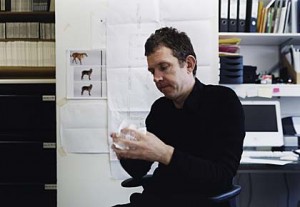
Anyone with more than a passing acquaintance with the practice of artist Martin Creed will know all about the fastidious numbering of his works. These begin with Work No.3 in 1986 (a yellow painting) and so far stretch as far as this year’s Work No. 1461 (an installation made with adhesive tape).
What might surprise you is that Creed’s appetite for order and record keeping extends to collecting sound files of every interview he undertakes. So when I catch him on the phone a technical hitch at his end throws the methodical artist.
“Wait, are you recording this?†he wants to know. “Can I get a copy of it?†And after the giving and receiving of assurances that I will later send him an MP3, we are ready to continue. It is quite clear that Creed takes the business of talking seriously.
This bodes well for those lucky enough to find themselves at the Freud Museum during Museums at Night 2013. On Thursday May 16 the Scottish artist will be on the spot, if not on the couch, as he improvises an after hours lecture, with the help of slide projections and a bit of music.
“It’s hard to do things,” he says. “Everything seems just as difficult as everything else: it’s just as much work to try to talk and say something that I think is alright as it is to try to fix and be okay with the shapes or colours in a painting or a sculpture or whatever.â€
Creed refuses to be drawn about finer details pertaining to the evening: “I’m not sure — I’ll probably try just to think out loud and talk about whatever comes upâ€.
But he does admit the event should resonate with his newfound surroundings. “Absolutely, aye,†he says, “I do psychoanalysis and I’m a fan of Freud. Yeah, I have been [in analysis] for a very long time.â€
Creed reveals he first saw an analyst in 1993: “I did it because I was desperate. I wanted to speak to someone.†Now he goes four times a week. “It’s a bit like going swimming or something like that: I think it’s an integral part of my life.â€
At any rate, intensive therapy is clearly commensurate with a blue chip art career. This most exacting of artists views the activity as labour: “It’s work and I feel like I have to keep doing it.†This may come as some surprise, considering how effortless the artist’s official numbered works appear to be.
In 2001 he won the Turner Prize for Work No.227: The lights going on and off. It is hard to imagine a more coolly minimal work than an empty room alternating between light and darkness. Creed has a professional detachment which belies his sometime inner turmoil.
Nevertheless, when he agreed to take part in Museum’s at Night, the Freud Museum was his first choice. “I’ve always liked visiting there. I feel like it’s a nice place, you know?†he says. “Just seeing the consulting room and the stuff he had around.”
But for someone with experience of therapy, Freud’s consulting room might be something of a lion’s den. Therapy and performance are bound to overlap in such a historic setting. And what to make of the rumour that the founder of psychoanalysis didn’t even like music.
“I didn’t know that but I don’t believe that,†Creed is adamant. “And if he said that I don’t believe him.â€
So then, what would Freud have thought of contemporary art itself? Surely he would have hated it? “I don’t know, maybe,†says Creed, then adds with a laugh: “I don’t know if I like itâ€.
But I remind the controversial artist that he once suggested that visitors should run around museums to see exhibits at speed. “I personally hate feeling as if I have to spend ages looking at things, as if I’ve got to be a good boy and read all the labels.
“The thing I like about museums is that you can come and go as you please, you know, especially if it’s free to get in,†he adds. “I like being able to go into a gallery and just see one painting and then go out again. I like that about galleries, as opposed to theatres where you’re stuck in your seat.â€
This sense of duty is something the artist wrestles with in his work. With regard to public speaking, he refers to “the feeling I have to take responsibility, the feeling that I’m responsible for everything I do. It has repercussions because it affects other people.â€
“Included in that feeling is a feeling of not wanting to be…sort of fake…because I sometimes have the feeling when I’m talking or when I’m working that I’m doing something somehow conventional — the usual — as if I’ve been programmed. I don’t want to be like that and it feels like a fight not to.â€
As you can see, as a veteran of psychotherapy, Creed knows how to dissect an emotion. But strange to say, he aims to bring the results of such introspection back “into the world out of my little room on my own, because it’s scary and exciting and maybe it’s the way I learn about things really.â€
“Basically I don’t want to be a w***er sitting at home, and actually I think that’s probably why I want to do exhibitions and gigs and talks and stuff — to basically work on things in the world outside of my own domain, to get out of the house†he says.
This calls to mind the celebrated slogan of Work No. 232, ‘the whole world + the work = the whole world’. It is something of a koan which makes you wonder about the unconscious origins of art or music. The metaphorical lights are sure to go on and off and on again when Creed does his thing.
Advance booking required for the May 16 event at the Freud Museum. Visit the gallery website for more. Piece written for Culture24.